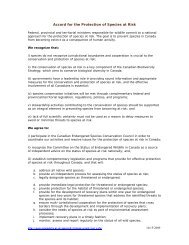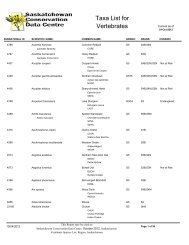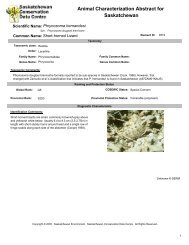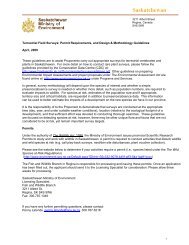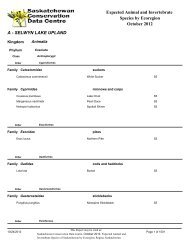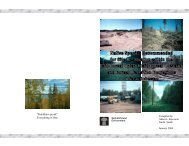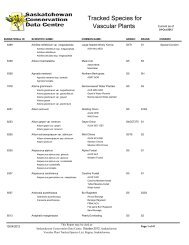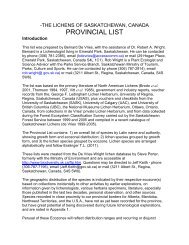getting to know your boreal lichens - Saskatchewan Conservation ...
getting to know your boreal lichens - Saskatchewan Conservation ...
getting to know your boreal lichens - Saskatchewan Conservation ...
You also want an ePaper? Increase the reach of your titles
YUMPU automatically turns print PDFs into web optimized ePapers that Google loves.
GETTING TO<br />
KNOW<br />
YOUR<br />
BOREAL LICHENS<br />
of<br />
<strong>Saskatchewan</strong>, Canada<br />
Series IV<br />
Bernard de Vries<br />
Irma de Vries<br />
Pho<strong>to</strong>graph © Bernard de Vries<br />
Posted/Compiled by: Steve Porter<br />
<strong>Conservation</strong> Data Centre – Fish & Wildlife Branch<br />
<strong>Saskatchewan</strong> Environment<br />
June, 2007<br />
A pdf version of this document can be found at http://www.biodiversity.sk.ca/ftp.htm
PREFACE<br />
Series IV is a continuation of Series II<br />
(http://www.biodiversity.sk.ca/ftp.htm), and<br />
describes, in similar format, additional common<br />
<strong>boreal</strong> <strong>lichens</strong>, occurring across the <strong>boreal</strong> forest. A<br />
number of these species can also be found in the<br />
Aspen Parkland Ecoregion.<br />
The scientific name, of a lichen refers <strong>to</strong> its fungal<br />
component, while the algal component has its own<br />
scientific name. These scientific names are <strong>know</strong>n<br />
<strong>to</strong> lichenologists and students of <strong>lichens</strong> worldwide<br />
because they are stable, but are cumbersome and<br />
difficult <strong>to</strong> pronounce or remembered by the<br />
uninitiated. This prompted the need for a more<br />
easier common English name for most lichen<br />
species. However, such names can vary and often<br />
more, or different, common names are given <strong>to</strong> a<br />
certain species.<br />
Scientific names have two components: genus and<br />
species. Lichens grouped in<strong>to</strong> the same genus have<br />
some characteristics in common. For example in<br />
Cladonia; most of the <strong>lichens</strong> belonging <strong>to</strong> this<br />
genus are often upright, having basal scale-like<br />
structures and cups, with the scale-like structures<br />
the most common fac<strong>to</strong>r. The specific names are<br />
mostly Latinized descriptions of specific feature:<br />
Peltigera scabrosa ‘scabra - rough’, referring <strong>to</strong> the<br />
rough upper surface of this species, Melanelia<br />
exasperatula referring <strong>to</strong> ’exasperatis’ rough<br />
(roughness on the surface).<br />
The name of the author who described the lichen<br />
first is given after the species: Cladonia cristatella<br />
Tuck. (after Tuckermann, a German Lichenologist).<br />
However, when a species has been subsequently<br />
placed in<strong>to</strong> a different genus, then the author for this<br />
new combination is listed in parentheses: Cladonia<br />
chlorophaea (Flörke) Spreng, after Flörke and<br />
Sprengel - lichenologists.<br />
Studying <strong>lichens</strong> can require the collection of<br />
specimens. The collec<strong>to</strong>r must be mindful that over<br />
collecting of a species could lead <strong>to</strong> extirpation.<br />
Collect only what you need and leave enough<br />
material <strong>to</strong> ensure survival of the species. It is<br />
important <strong>to</strong> obtain permission <strong>to</strong> enter private land<br />
or <strong>to</strong> obtain collecting permits in<br />
National/Provincial parks. Specimens on grave<br />
s<strong>to</strong>nes, or protected structures should not be<br />
collected, but pho<strong>to</strong>graphed instead.<br />
Figure 1a Ecozones of <strong>Saskatchewan</strong>.<br />
Lichens are best transported home in paper lunch<br />
bags (not plastic, as this causes <strong>lichens</strong> <strong>to</strong> mold),<br />
and s<strong>to</strong>red in 10x15 cm packets for later study.<br />
Bulky species can be moistened <strong>to</strong> become pliable,<br />
then lightly pressed flat <strong>to</strong> prevent damage in<br />
s<strong>to</strong>ring. Specimens on s<strong>to</strong>ne can be collected with a<br />
small fragment of the substratum (always wear<br />
glasses when chipping s<strong>to</strong>ne) and then glued, with<br />
its attached lichen, <strong>to</strong> cardboard. A standard label<br />
10.2x5.1 (4x2”) is attached <strong>to</strong> the package stating<br />
the scientific and common name, author(s), location<br />
collected, etc.<br />
The intent of this Series was <strong>to</strong> foster an interest in,<br />
and popularize our diversified lichen flora by<br />
describing the characters of common <strong>lichens</strong> and<br />
summarizing their distribution. If this has been<br />
achieved then we have been successful.<br />
A pdf version of this document can be found at http://www.biodiversity.sk.ca/ftp.htm
The geographic distribution maps were prepared as<br />
dot maps using the Ecoregions of <strong>Saskatchewan</strong><br />
Map (Padbury and Ac<strong>to</strong>n. 1994, Figure 1a),<br />
whereby each dot within a dark shading represents<br />
the <strong>know</strong>n location and distribution within a<br />
Landscape Area (Figure 1b), while lighter shading<br />
shows the potential range for the species by<br />
Ecoregion within an Ecozone (Figure 1c). If<br />
available the site where the pho<strong>to</strong>graph was taken is<br />
marked *.<br />
Figure 1b. Landscape Areas within Ecoregions<br />
Some species show a wide distribution, ranging<br />
north in<strong>to</strong> the Taiga and Boreal Shield Ecozones,<br />
Arctic Regions, or south in<strong>to</strong> the Prairie Ecozone<br />
(Ecozones of <strong>Saskatchewan</strong> . Rowe, 1972, Figures<br />
1b, & 1c).<br />
Figure 1c Ecoregions within Ecozones<br />
Maps were prepared by Steve Porter, <strong>Conservation</strong><br />
Data Centre – Fish & Wildlife Branch,<br />
<strong>Saskatchewan</strong> Environment.<br />
WARNING<br />
The chemicals mentioned in the series are<br />
hazardous if used inappropriately, and users of these<br />
chemicals must ensure that they are used in a well<br />
ventilated area, and avoid direct skin contact.<br />
A pdf version of this document can be found at http://www.biodiversity.sk.ca/ftp.htm
Cladonia cholorophaea<br />
(Flörke ex Sommerf.) Sprengel<br />
Mealy pixie-cup, false pixiecup<br />
Location: Emma Lake, Boreal Transition Ecoregion,<br />
Boreal Plain Ecozone.<br />
Habitat: Acidic mineral soil in mixed <strong>boreal</strong> forest.<br />
Geographic Distribution: Widespread throughout the<br />
<strong>boreal</strong> forest; scattered across the Aspen Parkland and<br />
Moist Mixed Grassland Ecoregions. Also reported for<br />
the Cypress Hills Ecoregion in southwestern<br />
<strong>Saskatchewan</strong>.<br />
Description: This cup lichen has upright fruiting stalks<br />
arising from abundant primary, deeply divided lobe-like<br />
structures without vegetative propagules. The fruiting<br />
stalks are pale greenish, hollow or gray-green, covered<br />
with fine powdery or grading <strong>to</strong> granular, diffuse <strong>to</strong><br />
sparse vegetative propagules, intergrading with small<br />
irregular patches of vegetative tissue. The flaring cups<br />
are broad, goblet-shaped, closed inside Large brown<br />
fruiting bodies are frequently produced on short<br />
proliferations from the cup margins.<br />
Chemical Reactions: PD+ red.<br />
Notes: Many <strong>lichens</strong> resemble mealy pixie-cup in many<br />
ways, especially Cladonia pyxidata (Pebbled pixie-cup)<br />
in colour and cup size. However, this lichen has <strong>to</strong>ngueshapes<br />
primary lobes, a shorter fruiting stalk, and small,<br />
rounded patches of vegetative structures in the cups and<br />
cup margins. Cladonia fimbriata (Trumpet lichen) is<br />
also similar <strong>to</strong> Mealy pixie-cup, but has more powdery<br />
masses of vegetative propagules, while cups are taller,<br />
narrower and ‘trombone’ shaped.<br />
A number of segregate species almost indistinguishable<br />
from Mealy pixie-cup, but clearly differ in ecology,<br />
geographic distribution, but mainly in their chemistry<br />
The open cups are thought <strong>to</strong> facilitate spore dispersal by<br />
falling raindrops splashing them out of the cups and<br />
transported elsewhere <strong>to</strong> new sites by air currents.<br />
__________________________________________<br />
A pdf version of this document can be found at http://www.biodiversity.sk.ca/ftp.htm
Cladonia cristatella<br />
Tuck.<br />
British Soldiers<br />
Location: Nipawin. Boreal Transition, Ecoregion.<br />
Boreal Plain, Ecozone.<br />
Habitat: On mossy soil, decaying wood or sometimes<br />
on tree bases in Coniferous or mixed <strong>boreal</strong> forests.<br />
Geographic Distribution: A North American species<br />
scattered across the <strong>boreal</strong> forest.<br />
Description: This showy forest lichen has persistent and<br />
abundant primary, finely divided, small scale like lobes,<br />
which as the fruiting stalks, are variable in colour. In the<br />
open, the colour tends <strong>to</strong> be yellowish, and in dappled<br />
light more greenish, or even ashy gray in shadier places,<br />
which also may produce some small lobes on the fruiting<br />
stalks. The underside, of the lobes, is white. The<br />
typically unbranched fruiting stalks arise from the<br />
primary lobes and are cylindrical, smooth, without small<br />
lobes or vegetative propagules, but with an outer<br />
protective fungal layer. Clusters of short branches at the<br />
summit give the impression of a cup. The quite large<br />
fruiting bodies are scarlet red, but can occasionally pale<br />
yellowish or orange.<br />
Chemical Spot Reactions: The vegetative body tests K-<br />
, C-, KC+ yellowish, and PD-.<br />
Notes: In older literature the species has been<br />
recognized as having many forms based on recognition<br />
of lobes present or absent on fruiting stalks, whether the<br />
fruiting bodies are not uniformly scarlet, or the position<br />
of fruiting bodies. These minor variations could very<br />
well be environmentally. The common name “British<br />
Soldiers” originated about 200 years ago, when the<br />
British red-coated soldiers arrived on the east coast.<br />
__________________________________________<br />
A pdf version of this document can be found at http://www.biodiversity.sk.ca/ftp.htm
Evernia mesomorpha<br />
Nyl.<br />
Boreal oak moss, Spruce moss<br />
Location: Emma Lake, Boreal Transition Ecoregion,<br />
Boreal Plain Ecozone.<br />
Habitat: White Spruce branches, and on branches and<br />
trunks of hardwoods in Mixed <strong>boreal</strong> forest.<br />
Geographic Distribution: Abundant across the <strong>boreal</strong><br />
forest and occurring in the Aspen Parkland and<br />
Grassland Ecoregions, including the Cypress Upland in<br />
southwestern <strong>Saskatchewan</strong>.<br />
Description: This species is semi pendent or tufted,<br />
composed or irregularly but abundantly divided,<br />
angularly rounded <strong>to</strong> partly flattened, soft and pliable<br />
yellow green branches. Abundant coarse masses of<br />
yellowish <strong>to</strong> grayish vegetative propagules occur on the<br />
angular ridges. No fruiting bodies are present. The<br />
inner fungal layer is white and loose.<br />
Chemical Spot Reactions: The upper lichen body tests<br />
KC+ yellow, Inner fungal strands UV+ ice<br />
-blue. Negative for K, C and PD.<br />
Notes: The species is often found with Beard <strong>lichens</strong><br />
(Usnea species), and because of similar colour often<br />
confused with this genus, which has a solid central<br />
fungal cord lacking in Boreal oak moss, which also is<br />
more pollution <strong>to</strong>lerant then the Beard <strong>lichens</strong>. Another<br />
lichen Boreal oak moss can be mistaken for is Ramalina<br />
dilacerata (Punctured ramalina), which although similar<br />
in habit and colour, has flattened branches, and does not<br />
have a central cord nor vegetative propagules. The<br />
genus name Evernia apparently alludes <strong>to</strong> the Greek<br />
word for ’ growing well’ , but could also reflect on its<br />
abundance in the <strong>boreal</strong> forest.<br />
Oakmoss <strong>lichens</strong> are no<strong>to</strong>riously slow growers, a few<br />
mm yearly.<br />
_____________________________________________<br />
A pdf version of this document can be found at http://www.biodiversity.sk.ca/ftp.htm
Melanelia exasperatula<br />
(Nyl.) Essel.<br />
Lustrous camouflage lichen,<br />
wart lichen<br />
Synonym: Parmelia exasperatula<br />
Location: Emma Lake, Boreal Transition Ecoregion,<br />
Boreal Plain Ecozone.<br />
Habitat: White Spruce bark in Mixed <strong>boreal</strong> forest<br />
Geographic Distribution: Across the <strong>boreal</strong> forest, and<br />
occasional extending in<strong>to</strong> the Aspen Parkland. Also<br />
reported for the Cypress Upland Ecoregion in<br />
southwestern <strong>Saskatchewan</strong>.<br />
Description: This not <strong>to</strong>o uncommon leaf lichen has<br />
flat or marginally slightly raised, loosely <strong>to</strong> moderately<br />
appressed olive-green <strong>to</strong> olive-brown, broadly<br />
rounded,.smooth <strong>to</strong> slightly wrinkled and often very<br />
shiny lobes. The upper surface has no powdery<br />
vegetative propagules, only hollow vegetative structures,<br />
which start as small bumps constricted first at the base,<br />
later becoming inflated, lustrous club-shaped or barrelshaped,<br />
with simple or occasionally forked tips (insert).<br />
The under surface is pale <strong>to</strong> dark brown and smooth <strong>to</strong><br />
wrinkly, bearing many attachment structures. Fruiting<br />
bodies are mostly absent<br />
Chemical Reactions: None for the inner fungal layer.<br />
Notes: Lustrous camouflage lichen can be confused with<br />
some similar olive <strong>to</strong> brown camouflage species, having<br />
cylindrical vegetative propagules and no chemical<br />
reaction for the inner fungal layer. Melanelia<br />
subelegantula (Subelegant brown) has slightly flattened<br />
but not hollow vegetative outgrowth on its upper<br />
surface, and lobes are somewhat covered with a powdery<br />
substance. Melanelia elegantula (Elegant brown) has<br />
small granular <strong>to</strong> cylindrical but non-inflated or flattened<br />
vegetative propagules. Both can be found on bark in a<br />
similar habitat as Lustrous camouflage lichen.<br />
The species name exasperatula is derived from the Latin<br />
word exasperis meaning ‘roughness‘, probably referring<br />
<strong>to</strong> the rough upper surface.<br />
__________________________________________<br />
A pdf version of this document can be found at http://www.biodiversity.sk.ca/ftp.htm
Peltigera canina<br />
(L.) Willd.<br />
Dog lichen<br />
Location: Nipawin, Boreal Transition Ecoregion,<br />
Boreal Plain Ecozone.<br />
Habitat: Needle humus over mineral soil in open Jack<br />
Pine forest.<br />
Geographic Distribution: Common across the <strong>boreal</strong><br />
forest; infrequently in the Aspen Parkland Ecoregion.<br />
Also reported for the Cypress Upland Ecoregion in<br />
southwestern <strong>Saskatchewan</strong>.<br />
Description: Dog lichen is a fairly large and more or<br />
less circle forming lichen with pale lobes when wet,<br />
becoming brownish grey when dry. The dull., flat lobes<br />
are up <strong>to</strong> 25 mm wide, marginally slightly wavy and<br />
turned down, with a fine hairy covering, especially near<br />
the lobes tips. The lower surface is whitish or brownish<br />
<strong>to</strong>wards the centre, with conspicuous flat <strong>to</strong> rounded<br />
brown, raised veins that become off white at the<br />
margins, and with conspicuous pale, tufted or brush-like<br />
holdfast structures, often becoming confluent and matforming,<br />
especially <strong>to</strong>ward the centre. The large,<br />
chestnut- or blackish brown fruiting bodies are saddle<br />
shaped, vertical on erect lobe margins.<br />
Chemical Reactions: None<br />
Notes: Dog lichen is very similar <strong>to</strong> Peltigera rufescens<br />
(field dog lichen) and Peltigera scabra (rough pelt). The<br />
former is more brittle, with smaller upturned lobe tips<br />
and a thicker white hairy covering on the upper surface.<br />
The latter lacks hairs and has a roughened surface. Both<br />
occur in similar habitat.<br />
According <strong>to</strong> the Doctrine of Signatures dog pelt was<br />
recommended as a cure for rabies, because of the erect<br />
fruiting bodies bearing a resemblance <strong>to</strong> ‘dog teeth’ .<br />
Herbalists of old valued this species as a remedy for<br />
liver complaints, because its growth form resembles a<br />
liver.<br />
__________________________________________<br />
A pdf version of this document can be found at http://www.biodiversity.sk.ca/ftp.htm
Peltigera rufescens<br />
(Weiss) Humb.<br />
Field dog lichen, felt pelt<br />
Location: Prince Albert. Boreal Transition Ecoregion.<br />
Boreal Plain Ecozone.<br />
Habitat: Needle humus over dry, sandy soil on exposed<br />
and sunny locations in open Jack Pine forest.<br />
Geographic Distribution: Scattered throughout the<br />
<strong>boreal</strong> forest, and reported for Cypress Hills Inter-<br />
Provincial Park, Cypress Upland Ecoregion.<br />
Description: This foliose lichen has small <strong>to</strong> medium<br />
sized gray <strong>to</strong> brown crisp lobe margins, usually with an<br />
appressed white covering of fine hairs on the upper<br />
surface. The underside has distinct raised veins with pale<br />
margins, but tending <strong>to</strong> be come darker elsewhere. The<br />
attachment structures are thick tufts of fungal strands,<br />
coalescing <strong>to</strong>wards the centre in<strong>to</strong> an almost continuous<br />
mat, especially noticeable along the veins. The common<br />
dark-red brown fruiting bodies are saddle-shaped on<br />
upright lobes.<br />
Chemical Reactions: None<br />
Notes: Although Field dog-lichen resembles Peltigera<br />
canina (Dog lichen) which also occurs in a similar<br />
habitat and substratum, it is more brittle, and has smaller<br />
narrower lobes, upturned at the margins, and with a<br />
strong covering of fine hairs.<br />
__________________________________________<br />
A pdf version of this document can be found at http://www.biodiversity.sk.ca/ftp.htm
Physcia stellaris<br />
(L.) Nyl.<br />
Star rosette lichen, black eyed<br />
rosette, grey star lichen<br />
Location La Ronge, mixed Boreal Upland Ecoregion,<br />
Boreal Plain Ecozone.<br />
Habitat: On Balsam Poplar bark. Also found on bark of<br />
other trees and tall shrubs in mixed <strong>boreal</strong> forest.<br />
Geographic Distribution: Widespread throughout the<br />
<strong>boreal</strong> forest and scattered across the Aspen Parkland,<br />
and Cypress Upland Ecoregions.<br />
Description: This pale gray, often centrally darkened<br />
leaf lichen, forms pale gray rosettes of narrow, more or<br />
less smooth, uniform lobes, lacking distinct white<br />
spotting on the upper surface although older parts can<br />
have some spotting. The flat <strong>to</strong> convex lobes radiate<br />
outwards in a star-like pattern, and can become crowded<br />
in older plants. There are no vegetative propagules.<br />
Copious quite large dark brown <strong>to</strong> almost black fruiting<br />
bodies are crowded near the center, and mostly devoid of<br />
a white frosting on their surface. The lower surface is<br />
white <strong>to</strong> tan with many brown holdfast structures.<br />
Chemical Reactions: The inner fungal layer tests K-.<br />
Notes: Star rosette lichen is often confused with the<br />
similar leaf lichen Physcia aipolia (Hoary rosette<br />
lichen), which is K+ for the fungal layer, and has a<br />
copious white spotting. While both species can be found<br />
on the same tree, they appear <strong>to</strong> be vertically stratified;<br />
Physcia stellaris (Black eyed rosette) mainly occurs<br />
higher on the tree, while Physcia aipolia grows nearer<br />
the ground.<br />
__________________________________________<br />
A pdf version of this document can be found at http://www.biodiversity.sk.ca/ftp.htm
Ramalina dilacerata<br />
(Hoffm.) Hoffm.<br />
Punctured ramalina,<br />
Perforated ramalina<br />
Synonym: Fistulariella dilacerata, Fistulariella minuscule,<br />
Ramalina minusuila<br />
Location: Duck Mountain Provincial Park. Boreal<br />
Transition Ecoregion. Boreal Plain Ecozone.<br />
Habitat: White Birch bark and on branches and twigs<br />
of various trees and sometimes tall shrubs in mixed<br />
forest.<br />
Geographic Distribution: Widespread throughout the<br />
<strong>boreal</strong> forest, and occurring in the Aspen Parkland and<br />
Cypress Upland Ecoregions.<br />
Description: Punctured ramalina is a greenish yellow,<br />
short tufted species, with rather smooth, hollow, inflated<br />
branches with many perforations in<strong>to</strong> the inner fungal<br />
layer especially near branch bases. Its outer protective<br />
layer is rather thin. No vegetative propagules are present.<br />
Fruiting bodies are common, and mainly at or close <strong>to</strong><br />
the branch tips, although some do occur marginally. The<br />
disks are pale yellow with a light frosted appearance.<br />
Chemical Reactions: All spot tests are negative.<br />
Notes: This lichen is similar in colour and habitat <strong>to</strong><br />
some species of Usnea species (Beard lichen) or Evernia<br />
mesomorpha (Boreal oak moss), but lacks a solid central<br />
cord as in Beard <strong>lichens</strong>, nor does it have vegetative<br />
propagules as in Boral oak moss. The name Ramalina<br />
comes from the Latin ramalia, meaning ‘twigs‘,<br />
probably referring <strong>to</strong> it preference for branches and<br />
twigs.<br />
__________________________________________<br />
A pdf version of this document can be found at http://www.biodiversity.sk.ca/ftp.htm
Umbilicaria muehlenbergii<br />
(Ach.) Tuck.<br />
Plated rock tripe<br />
Synonym: Ac<strong>to</strong>nogyra muehlengergia, Gyrophora muehlenbergii<br />
Location: Amisk Lake, Southwest of Creigh<strong>to</strong>n,<br />
Churchill River Upland Ecoregion, Boreal Shield<br />
Ecozone.<br />
Habitat: On large outcroppings within mixed <strong>boreal</strong><br />
forest.<br />
Geographic Distribution: Scattered throughout the<br />
<strong>boreal</strong> forest.<br />
Description: This dark brown foliose lichen is attached<br />
<strong>to</strong> its substratum by a single central holdfast, and usually<br />
grows in a distinct circular form. The upper surface is<br />
occasionally cracked but not distinctly segmented, with a<br />
smooth <strong>to</strong> slightly roughened upper surface, which is<br />
shallowly pitted, folded or wavy. The pale <strong>to</strong> dark<br />
brown lower surface is roughened with many small<br />
sharp bumps, covered with a network of overlapping<br />
pale <strong>to</strong> dark brown plates, which can form marginally<br />
slender filaments. The many fruiting bodies consist of<br />
radiating, branched ridges split by fissures and usually<br />
sunken in<strong>to</strong> depressions on the upper surface.<br />
Chemical Reactions: Fungal strand C+ red, KC+ red,<br />
K-, PD-.<br />
Notes: A network of plates on the lower surface is<br />
characteristic of many rock tripes. Plated rock tripe has<br />
only pale <strong>to</strong> dark brown but not black plates;<br />
Umbilicaria <strong>to</strong>rrefacta (Punctured rock tripe) has also<br />
plates but mainly restricted <strong>to</strong> the central holdfast, while<br />
the lower surface is pale brown. The fruiting bodies of<br />
plated rock tripe have many ridges, radiating from the<br />
centre, rather than forming concentric ridges found in<br />
other species. Rock tripes contain some minerals and<br />
vitamins, and browsed by Musk Oxen as a winter food.<br />
__________________________________________<br />
A pdf version of this document can be found at http://www.biodiversity.sk.ca/ftp.htm
Usnea hirta<br />
(L.) F.H. Wigg.<br />
Bristly beard lichen,<br />
Shaggy old man’s beard,<br />
Shaggy beard lichen<br />
Synonym: Usnea variolosa<br />
Location: Emma Lake, Boreal Transition Ecoregion,<br />
Boreal Plain Ecozone.<br />
Habitat: Old hard weathered wood within mixed <strong>boreal</strong><br />
forest.<br />
Geographic Distribution: Across the <strong>boreal</strong> forest and<br />
extending south in<strong>to</strong> the more northern Aspen Parkland.<br />
Also reported for the Cypress Upland Ecoregion in<br />
southwestern <strong>Saskatchewan</strong>.<br />
Description: Bristly beard lichen is a rather small tufted<br />
or short pendant branched hair lichen with pale<br />
yellowish green branches and base. Numerous short side<br />
branches usually are perpendicular <strong>to</strong> the main stem and<br />
have many small spines. They are ridged and angular<br />
upon cross-section, without powdery vegetative<br />
structures, but bearing many copious minute vegetative<br />
outgrowths with an outer protective layer. The <strong>to</strong>ugh,<br />
thick white inner fungal strand is lax. There are no<br />
fruiting bodies present.<br />
Chemical Reactions: No reactions for the inner fungal<br />
strand.<br />
Notes: This lichen could be mistaken for Usnea<br />
subfloridana (Nit beard) which has numerous small<br />
warty bumps and tiny peg-like vegetative propagules,<br />
mixed with powdery vegetative structures on its<br />
branches. In general, the genus Usnea, is recognized by<br />
its <strong>to</strong>ugh, flexible, inner fungal strand. This strand can<br />
be seen by holding a stem section and pulling it gently<br />
apart. The cord gives strength and resilience <strong>to</strong> the<br />
lichen body. Usnea species also provide a valuable<br />
winter nutrient for ungulates, and due <strong>to</strong> their large<br />
surface area, are valuable indica<strong>to</strong>rs of atmospheric<br />
pollution. The genus name Usnea comes from the<br />
Arabic word meaning ’ moss’ while the species name<br />
hirta comes from the Latin for ’ hairy or ’ shaggy’ .<br />
__________________________________________<br />
A pdf version of this document can be found at http://www.biodiversity.sk.ca/ftp.htm
Vulpicida pinastri<br />
(Scop.) J.E. Mattsson & M.J. Lai<br />
Powdered sunshine lichen<br />
Synonym: Cetraria pinastri, Tuckermannopsis pinastri<br />
Location: Cypress Hills Interprovincial Park, Cypress<br />
Upland Ecoregion, Prairie Ecozone.<br />
Habitat: Lodgepole Pine bark and on twigs and<br />
branches of deciduous trees and shrubs in open<br />
Lodgepole Pine forest.<br />
Geographic Distribution: Frequently throughout the<br />
<strong>boreal</strong> forest, and the Cypress Hills Upland Ecoregion.<br />
Description: This species forms greenish-yellow <strong>to</strong><br />
yellow foliose rosettes with flattened, adherent, or<br />
marginally uplifted lobes mostly 2-5 mm wide. Lobe<br />
margins are can be finely divided or ruffled, dissolving<br />
in<strong>to</strong> fine powdery masses of brilliant yellow vegetative<br />
propagules. Fruiting bodies are rare, and mostly absent.<br />
The lower surface is pale yellow <strong>to</strong> almost white, with<br />
sparse <strong>to</strong> abundant pale <strong>to</strong> dark brown attachment<br />
structures.<br />
Chemical Reactions: None.<br />
Notes: This very showy forest lichen is the only yellow<br />
bark dwelling species in our <strong>boreal</strong> forest. The yellow<br />
colour comes from two poisonous lichen substances,<br />
pinastric and vulpinic acids, which are thought <strong>to</strong> be a<br />
grazing insects or invertebrates repellent. In Europe it<br />
was used <strong>to</strong> kill wolves and foxes; indeed the generic<br />
name vulpicida comes from the Latin vulpes ’ Fox’ and<br />
cadeare ’ <strong>to</strong> kill’ .<br />
_________________________________________<br />
A pdf version of this document can be found at http://www.biodiversity.sk.ca/ftp.htm
Xanthoria hasseana<br />
Räsänen.<br />
Poplar sunburst lichen<br />
Location: North of Prince Albert.<br />
Habitat: Bark of Balsam Poplar in mixed forest.<br />
Geographic Distribution: Across the Aspen<br />
Parkland and in<strong>to</strong> the Boreal Transition Ecoregions.<br />
Description: A common and widespread medium sized<br />
yellow-orange <strong>to</strong> orange foliose lichen, which form<br />
small, loosely attached rosettes, with finely divided,<br />
overlapping lobes. Vegetative propagules are absent.<br />
The white, lower surface has many somewhat elongated<br />
attachment structures. The numerous fruiting bodies<br />
have a dark orange disk with margins the same colour as<br />
the lichen body. Sometimes characteristic white fungal<br />
extensions can bee seen at underside of these margins.<br />
Chemical Reactions: K+ dark purple for the outer<br />
protective layer.<br />
Notes: A similar species Xanthoria polycarpa (Pincushion<br />
sunburst lichen) is also yellow-orange <strong>to</strong> orange,<br />
with many fruiting bodies in the center, and occurs in the<br />
same habitat. It, however, lacks true attachment<br />
structures, and small marginal fungal outgrowths at its<br />
fruiting bodies.<br />
__________________________________________<br />
A pdf version of this document can be found at http://www.biodiversity.sk.ca/ftp.htm
References<br />
Additional information on these species can be found in the following reference list.<br />
Brodo, I.M., S.D. Sharnoff, and S. Sharnoff. 2001. Lichens of North America. Yale University Press,<br />
New Haven, U.S.A.<br />
Johnson, D., L. Kershaw, A. MacKinnon, and J. Pojar. 1995. Plants of the Western Boreal Forest &<br />
Aspen Parkland. Lone Pine, Edmon<strong>to</strong>n, Alberta, Canada.<br />
Thomson, J.W. 19944. American Arctic Lichens 1 The Macro<strong>lichens</strong>. Columbia State University Press.<br />
New York, U.S.A.<br />
Vitt,D.H., E. Marsh, and R.B. Bovey. 1988. Mosses, Lichens & Ferns of Northwest North America.<br />
Lone Pine, Edmon<strong>to</strong>n, Alberta, Canada.<br />
Map References<br />
Padbury, G.A. and D.F. Ac<strong>to</strong>n. 1994. Ecoregions of <strong>Saskatchewan</strong> map. Agriculture and Food Canada.<br />
Available from Information Services Corporation, <strong>Saskatchewan</strong>.<br />
Chemical Abbreviations: C = sodium hypochloride, K = potassium hydroxide, KC = a combination of K & C,<br />
PD = paraphenylenediamine, UV=ultra violet light.<br />
The SKCDC is always interested in <strong>your</strong> plant/animal observations. Please visit http://www.biodiversity.sk.ca/<br />
or contact Steve Porter, sporter@serm.gov.sk.ca.<br />
A pdf version of this document can be found at http://www.biodiversity.sk.ca/ftp.htm



